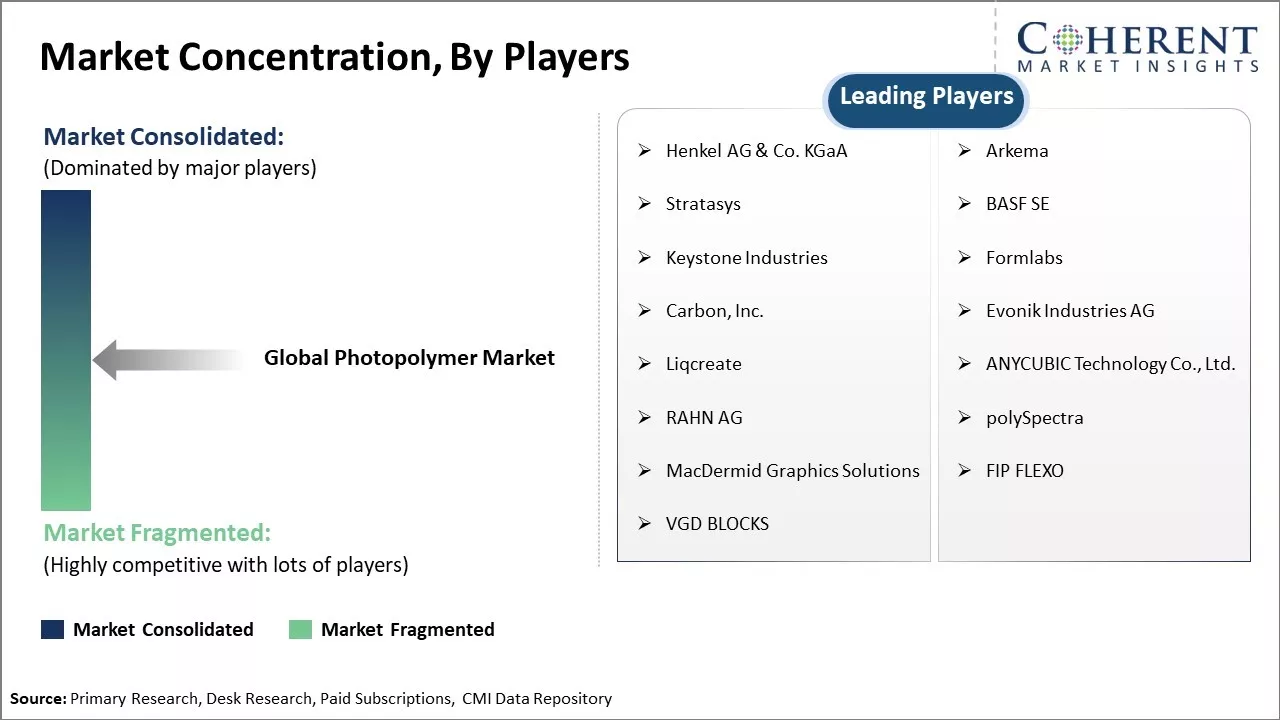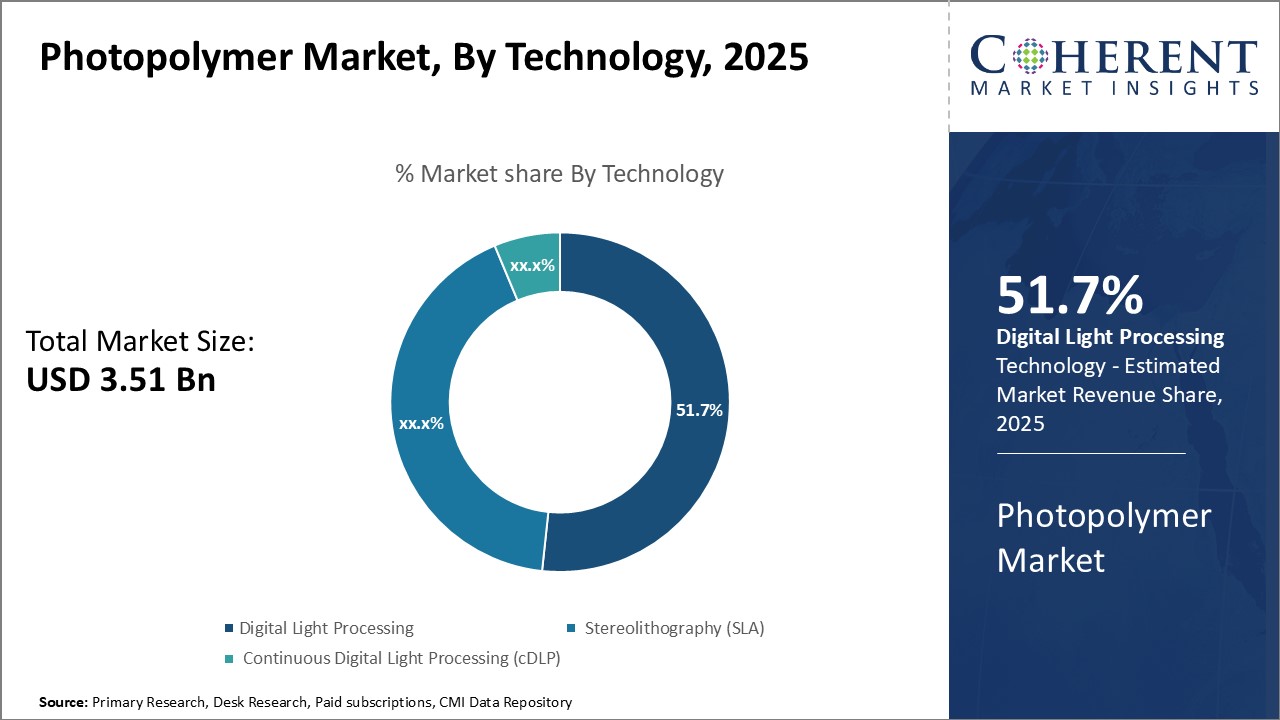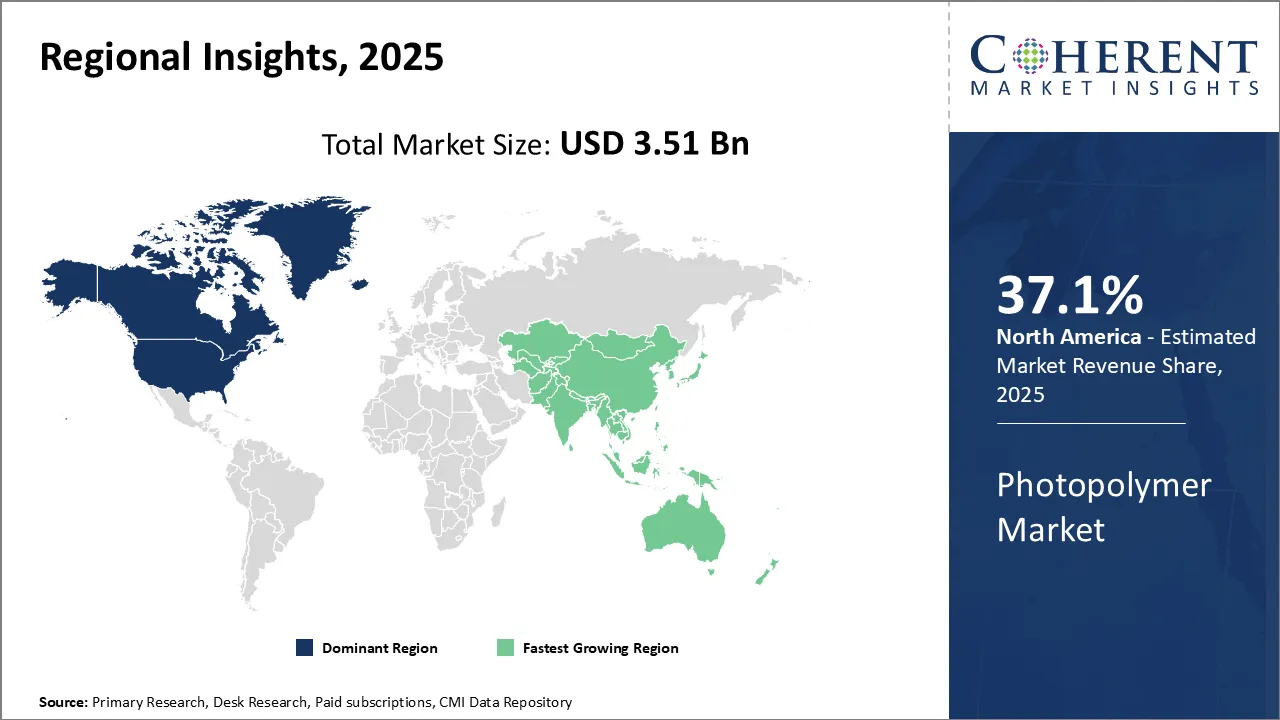Photopolymer Market Size and Trends
Global photopolymer market is estimated to be valued at USD 3.51 Bn in 2025 and is expected to reach USD 7.15 Bn by 2032, exhibiting a compound annual growth rate (CAGR) of 10.7% from 2025 to 2032.

Discover market dynamics shaping the industry: Download Free Sample
Global photopolymer market is expected to witness positive growth over the forecast period due to factors such as growing demand for 3D printing across various industries and technological advancements in photopolymer materials. Photopolymers find wide application in 3D printing as this help to create strong yet flexible 3D printed parts easily and quickly. 3D printing is gaining popularity in industries such as consumer goods, automotive, aerospace and defense due to its ability to produce customized and complex parts. Moreover, ongoing research & development in the field has led to development of newer photopolymer materials with improved properties such as high resolution, durability and temperature resistance. This expands application areas of photopolymers, and thus, boosts their demand.
Photopolymer Adoption across Industries
Growing adoption of photopolymers across various industries such as printing, healthcare, electronics can drive the growth of the global photopolymer market. Photopolymers find wide usage in stereolithography 3D printing owing to their properties like high accuracy, reliability and ability to produce complex geometries easily. 3D printing industry has been witnessing exponential growth over the past few years due to increasing demand from automotive, aerospace, consumer goods industries for prototyping as well as production applications. Photopolymers create precise plastic prototypes and customized products with complex internal structures, which was earlier not possible through conventional manufacturing methods. Another major industry boosting demand for photopolymer is healthcare where photopolymers are utilized for manufacturing hearing aids, dental crowns, surgical guides through 3D printing. The ability of photopolymers to quickly produce biocompatible scaffolds and implants with intricate designs make them ideal for such applications. With growing geriatric population worldwide requiring such medical devices, there has been increasing usage of photopolymers in healthcare 3D printing. Photopolymers are also used in electronics industry. Companies are exploring the feasibility of 3D printing flexible and stretchable electronic circuits and devices using photopolymers which can potentially reduce manufacturing costs and spur innovations.
Market Concentration and Competitive Landscape

Get actionable strategies to beat competition: Download Free Sample
Emergence of Advanced Photopolymer Formulations
Continuous product innovation and development of newer advanced photopolymer formulations by the manufacturers can drive the market growth. Major players are investing heavily in R&D to enhance the properties of photopolymers such as resolution, surface finish, stiffness, chemical and wear resistance. This allows them to be suitable for a wider range of high-performance applications. Specialty photopolymers with high heat resistance are being specifically designed for end use industries like aerospace where components require durable finishes. Elastic photopolymers mimicking the flexibility of human tissue enables better medical models for surgeons. Technology improvements have also paved way for new genres of photopolymers like LCD (Liquid Crystal Display) screens and photoresists that are used extensively in the semiconductor sector. Manufacturers are engaged in new product launches of advanced polymers, thus, catering to emerging application areas.
Key Takeaways of Analyst:
Global photopolymer market is expected to witness growth due to its increasing use across various industries such as 3D printing, graphical arts, microelectronics, telecom fiber, and healthcare. Rising demand for prototyping and increased adoption of 3D printing in various end-use industries can drive the market growth. Photopolymers allow for high resolution printing, and this boosts their use in 3D applications. Healthcare also provides opportunities owing to emerging photopolymer technologies for tissue engineering and medical devices manufacturing.
Availability of substitute technologies and raw material price volatility can hamper the market growth. Technologies such as laser sintering offer substitutes, limiting the growth potential of photopolymers. Furthermore, fluctuations in the prices of key raw materials including acrylates and epoxies can negatively impact manufacturers' profits.
Asia Pacific region dominates the global photopolymer due to rising electronics and healthcare industries in China and India. Growing manufacturing activity boosts demand for photopolymer from countries like Vietnam, Malaysia, and Indonesia. North America is projected to witness notable growth, owing to a well-established 3D printing industry and significant research & development investments in the region.
Market Challenges: Threat from substitute technologies
Threat from substitute technologies is a major restraining factor for the global photopolymer market's growth. Rapid advancements in alternative 3D printing technologies like fused deposition modeling, stereolithography, binder jetting etc. allow manufacturers to achieve high resolution outputs at a lower cost as compared to photopolymer-based 3D printing solutions. These substitutes offer improved part properties, better print speeds and cost advantages. For example, as per a 2021 report by the European Union on New Industrial Policy, stereolithography now allows the production of parts with finer details and resolution compared to photopolymer systems. Similarly, binder jetting processes have significantly higher build volumes and print speeds. The easy availability of low-cost substitutes is persuading end-users to shift to alternative additive manufacturing methods from conventional photopolymer printing.
Market Opportunities: Emerging applications in electronics industry
The emerging applications in electronics industry promises to provide significant opportunities for the global photopolymer market in the coming years. Photopolymer resins and materials are increasingly finding widespread usage in 3D printing technologies which are revolutionizing the prototyping and manufacturing processes across several electronics domains. 3D printed designs and components provide manufacturing advantages over traditional methods in terms of speed, reduced lead time and geometric flexibility which allows conceptualizing complex designs with ease. This is driving many electronics giants to invest heavily in adopting 3D printing for producing prototypes and non-critical components.

Discover high revenue pocket segments and roadmap to it: Download Free Sample
Insights, By Technology: Precision and design flexibility drives the stereolithography (SLA) segment growth
In terms of technology, stereolithography (SLA) segment is estimated to contribute the 51.7% share of the market in 2025, owing to its ability to offer precision and design flexibility. SLA works by using ultraviolet lasers to cure liquid photopolymer resin layer by layer, allowing it to produce parts with intricate details and complex geometries that would be difficult or impossible to manufacture through traditional methods. The layer-by-layer curing process delivers highly accurate dimensions and tolerances. It is capable of achieving resolutions up to 0.001 inches, making it ideal for prototyping and producing end-use parts that require tight specifications. SLA's design flexibility also stems from its ability to 3D print complex geometries without the need for tools, molds or dyes typically required in injection molding. This makes it very well-suited for producing customized and personalized products in low volumes. Its precision and design flexibility has boosted demand for SLA in industries such as consumer products, medical, dental and electronics that demand accurate and complex 3D printed parts.
Insights, By Performance: Performance drives adoption in industrial applications
In terms of performance, high performance segment is estimated to contribute the 37.2% share of the market in 2025. 3D printing technologies utilized in industrial applications such as manufacturing require high performance capabilities to produce functional end-use parts. High performance photopolymers are engineered to deliver properties such as high temperature resistance, mechanical strength, stiffness and durability. These can withstand higher temperatures, impact loads and repeated stresses over long periods of use. There has been increase in adoption of high-performance photopolymers in the manufacturing of tooling, molds and functional prototypes that will go through multiple production cycles or be deployed in demanding work environments. Their mechanical properties matching those of injection molded polymers allow for tooling printed with high performance photopolymers to be used directly in industrial processes. This reduces lead times and offers more design flexibility compared to traditional tooling production methods.
Insights, By Application: Medical and dental drive growth in specialized applications
In terms of application, dental segment is estimated to contribute the 35.9% share of the market in 2025. Photopolymers enable advanced 3D printing applications in the dental and medical industries through their biocompatibility. In dentistry, photopolymers are used to 3D print dental aligners, crowns, bridges, dentures and surgical guides with a high level of precision and custom fit for individual patients. This enhances treatment outcomes as compared to traditional methods. These are also increasingly being used to 3D print customized prosthetics, implants and anatomical models in the medical field due to their ability to mimic physical properties of bone and tissue. Photopolymers fulfill the stringent requirements of these specialized applications in terms of biocompatibility, material integrity and accurate reproduction of complex anatomies. Their success in dentistry and medicine boosts demand for sophisticated photopolymer solutions with properties optimized for the human body.
Regional Insights

Need a Different Region or Segment? Download Free Sample
North America has emerged as the dominant regional market for photopolymers with estimated 37.1% share in 2025. The strong presence of established photopolymer manufacturers along with a highly developed printing and graphic art industries are expected to drive the market growth in the region. Key players like DuPont, MacDermid, and Formlabs have significantly invested in R&D and product innovation to develop new photopolymer formulations. These efforts have paid off through more efficient and customized materials for various printing processes. Along with the manufacturing strength, demand from end-use segments like 3D printing, printing plates, and screen printing is significantly higher in North America compared to other regions. Growth in digital printing and additive manufacturing adoption across industries like consumer products, automotive, healthcare boosts photopolymer consumption. With its diverse economy and early technology adoption rates, applications of photopolymers continue to rise across various verticals. Trade relations within the region and with Asia and Europe have also ensured availability and affordability of photopolymers.
Asia Pacific region has emerged as the fastest growing regional market for photopolymers. Dynamic economies like China, India, and Southeast Asian countries are exhibiting strongest growth momentum. Rapid industrialization and manufacturing-led development over the past decade have increased the need for varied printing outputs. This has boosted demand for liquid and dry photopolymers for applications such as flexographic printing plates, photoresist chemicals, printed circuit boards, and 3D printing materials. Countries like China and Taiwan also have a burgeoning electronics and semiconductor industry that consumes photopolymers on a large scale. Asia Pacific is also emerging as a manufacturing powerhouse for photopolymers globally. Local giants like Pingguo, DIC, and Toyo Ink have rapidly expanded their production capacities and product portfolios, catering to the diverse requirements of local as well as international clients. Import barriers are relatively low in the region, allowing easier import of critical raw materials as well as transfer of technology. Coupled with lower labor and land costs, Asia Pacific offers highly competitive pricing for photopolymers without compromising on quality, driving higher consumption rates.
Market Report Scope
Photopolymer Market Report Coverage
| Report Coverage | Details | ||
|---|---|---|---|
| Base Year: | 2024 | Market Size in 2025: | USD 3.51 Bn |
| Historical Data for: | 2020 To 2024 | Forecast Period: | 2025 To 2032 |
| Forecast Period 2025 to 2032 CAGR: | 10.7% | 2032 Value Projection: | USD 7.15 Bn |
| Geographies covered: |
|
||
| Segments covered: |
|
||
| Companies covered: |
Henkel AG & Co. KGaA, Arkema, Stratasys, BASF SE, Keystone Industries, Formlabs, Carbon, Inc., Evonik Industries AG, Liqcreate, ANYCUBIC Technology Co., Ltd., RAHN AG, polySpectra, MacDermid Graphics Solutions, FIP FLEXO, VGD BLOCKS |
||
| Growth Drivers: |
|
||
| Restraints & Challenges: |
|
||
Uncover macros and micros vetted on 75+ parameters: Get instant access to report
Market Segmentation
- Technology Insights (Revenue, USD Bn, 2020 - 2032)
- Digital Light Processing (DLP)
- Stereolithography (SLA)
- Continuous Digital Light Processing (cDLP)
- Performance Insights (Revenue, USD Bn, 2020 - 2032)
- Low Performance
- Mid Performance
- High Performance
- Application Insights (Revenue, USD Bn, 2020 - 2032)
- Dental
- Medical
- Audiology
- Jewelry
- Automotive
- Consumer Goods
- Others
- Regional Insights (Revenue, USD Bn, 2020 - 2032)
- North America
- U.S.
- Canada
- Latin America
- Brazil
- Argentina
- Mexico
- Rest of Latin America
- Europe
- Germany
- U.K.
- Spain
- France
- Italy
- Russia
- Rest of Europe
- Asia Pacific
- China
- India
- Japan
- Australia
- South Korea
- ASEAN
- Rest of Asia Pacific
- Middle East & Africa
- GCC Countries
- Israel
- Rest of Middle East & Africa
- North America
- Key Players Insights
- Henkel AG & Co. KGaA
- Arkema
- Stratasys
- BASF SE
- Keystone Industries
- Formlabs
- Carbon, Inc.
- Evonik Industries AG
- Liqcreate
- ANYCUBIC Technology Co., Ltd.
- RAHN AG
- polySpectra
- MacDermid Graphics Solutions
- FIP FLEXO
- VGD BLOCKS
Share
Share
About Author
Yash Doshi is a Senior Management Consultant. He has 12+ years of experience in conducting research and handling consulting projects across verticals in APAC, EMEA, and the Americas.
He brings strong acumen in helping chemical companies navigate complex challenges and identify growth opportunities. He has deep expertise across the chemicals value chain, including commodity, specialty and fine chemicals, plastics and polymers, and petrochemicals. Yash is a sought-after speaker at industry conferences and contributes to various publications on topics related commodity, specialty and fine chemicals, plastics and polymers, and petrochemicals.
Missing comfort of reading report in your local language? Find your preferred language :
Transform your Strategy with Exclusive Trending Reports :
Frequently Asked Questions
EXISTING CLIENTELE
Joining thousands of companies around the world committed to making the Excellent Business Solutions.
View All Our Clients
